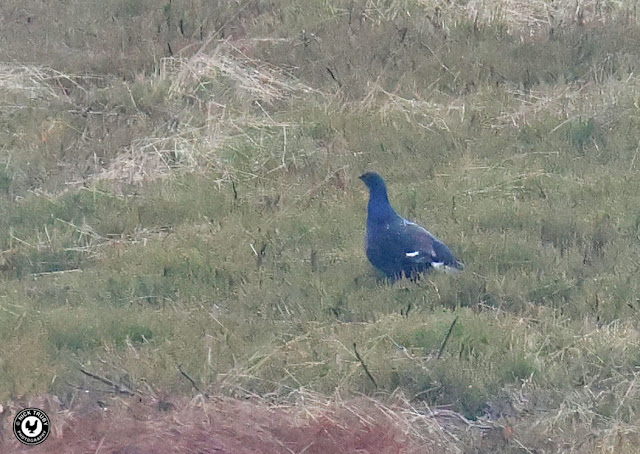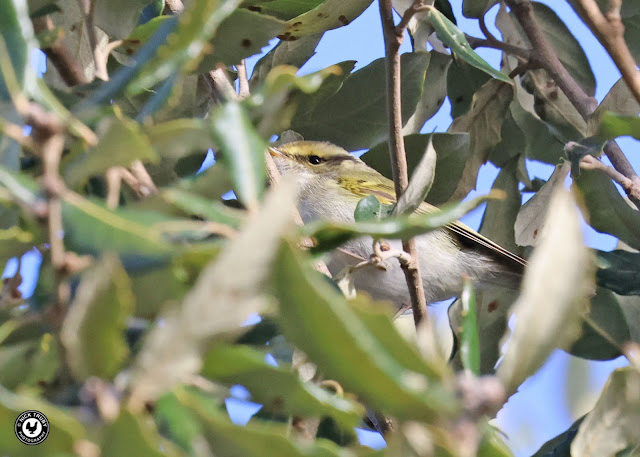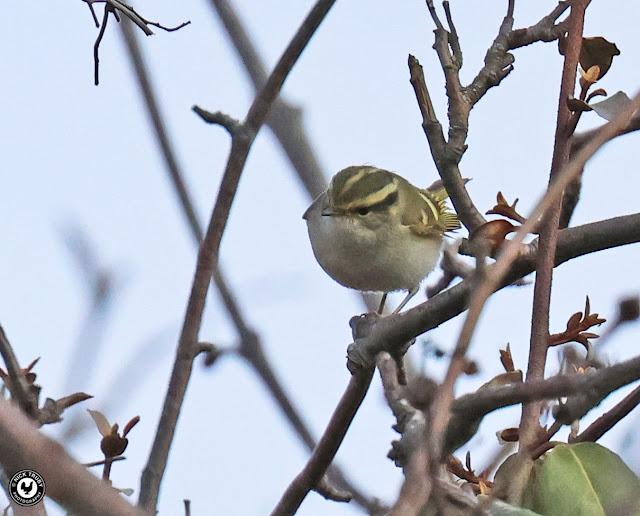Saturday 18 February; Surfing in North Wales
One of the birds that I'd set out to see this year because I hadn't seen one for a fair few, was a Surf Scoter, a type of sea-duck that is rarely found inland. So a trip to the coast is usually necessary in order to see them and I live a long way from the sea in every direction. However, some trips are worth making so we left home early and drove to the Llanddulas on the North Wales coast where at least two drake Surf Scoters had been present all winter along with the more familiar Common and Velvet Scoters. Over the previous few days the Scoters had been showing closer inshore than usual as well so we were optimistic of gaining some good views.
We arrived at a totally empty carpark at nine o'clock on a breezy and dull grey day. It took me less than a minute to find a Surf Scoter. The Scoter flock wasn't that close in and widely scattered so it took a little longer to find the other Surf Scoter and some Velvet Scoters. But in less than five minutes we had seen all of the three expected species of Scoter. I do love an easy twitch!
 |
| Surf Scoter (Melanitta perspicillata) |
There were other year ticks on offer as well, and we soon added some of the more expected species. A Shag had taken to hugging an old post that stood proud of the water. That post would become an important reference point when searching for the Scoters. Red-throated Divers and Red-breasted Mergansers were also offshore.
 |
| Shag (Phalacrocorax aristotelis) |
At times the Scoter flock was driven in closer to shore and I was able to get some slightly better shots. One day, fingers crossed, I'll catch up with a Surf Scoter on an inland water body and get close views like I did of the two juveniles at Helston Loe Pool over twenty years ago.
 |
| Common Scoter (Melanitta nigra) |
We now had time to seek out some other birds for our year list. A few miles along the coast is a place where Purple Sandpipers can be found. Unfortunately our arrival at Rhos-on-sea coincided with low tide which meant that instead of roosting on the sea wall rocks the birds would be foraging somewhere on the rocky foreshore. It took a good deal of searching and a helpfully placed Curlew before I spotted three of the target waders.
 |
| Purple Sandpiper (Calidris maritima) & Curlew (Numenius arquata) |
A small flock of Dunlin provided some extra entertainment and a scan of the beach revealed around fifty more Curlew, none of which I'd noticed before since their cryptic plumage rendered them almost invisible. When they broke cover then they became much easier to see.
 |
| Dunlin (Calidris alpina) |
We detoured to Rhyl and a field on the edge of the town where some Ruddy Shelduck had been reported. Unfortunately parking was impossible and we didn't want to walk back from where we could park so I ditched the car temporarily at the end of a farm track and remarkably spotted the flock of five birds two fields away. Once again Ruddy Shelduck wouldn't be allowable on any official list but for my own year list they are fine by me. I made the effort too see them after all. I'll just have to get 303 during the year.
 |
| Ruddy Shelduck (Tadorna ferruginea) |
Our route home took us, through choice, over some prime moorland where we know a very special bird can be found. Black Grouse wouldn't be lekking at four o'clock in the afternoon and certainly not in the rain that had set in but still I managed to find one feeding in the murk on an opposite hillside. Red Grouse were also seen in the heather.
 |
| Black Grouse (Lyrurus tetrix) |
 |
| Red Grouse (Lagopus lagopus scotica) |
Year List additions;
146) Surf Scoter, 147) Common Scoter, 148) Shag, 149) Kittiwake, 150) Red-throated Diver, 151) Purple Sandpiper, 152) Ruddy Shelduck, 153) Red Grouse, 154) Black Grouse
Sunday 19 February; Long Distance Twitching
Staines reservoir isn't that far from home but the Lesser Scaup which floated idly around in the furthest corner of the larger basin with a flock of Pochard couldn't have been much further away from the viewing point without flying off somewhere else. I could just about discern enough info from straining through the scope at full magnification to know that it wasn't any of the common species. In truth though, whether or not it was a Lesser Scaup, I could only take the identity for granted because of the fact that it had been at Staines for about a month previously so I assumed that it must be. Not the most satisfactory way to see my first Lesser Scaup for over ten years.
Luckily just a couple of weeks later the Lesser Scaup would relocate to Farmoor and show remarkably well at just a few metres distance! That will feature in a future blog.
At a similar distance although not quite as far, as the Lesser Scaup had been, were three Black-necked Grebes on the North basin, another underwhelming year tick.
A drake Smew had been seen regularly at Stockers Lake in Rickmansworth, just half an hour from Staines. We made the mistake of detouring there on the way home. A mistake because it seemed like half of the good folk of north-west London had decided to go to Stockers at the same time. The carpark was gridlocked and the whole site was teeming with families and dogs. Hardly conducive to any birding but we gave it a whirl anyway. We didn't find the Smew, it had probably wisely scarpered off to somewhere quieter but did get some nice views of a Jay and some Ring-necked Parakeets. We couldn't get away from the place quickly enough and breathed a huge sigh of relief when we finally got out of the murderous traffic situation in the carpark.
 |
| Jay (Garrulus glandarius) |
 |
| Ring-necked Parakeet (Psittacula krameri) |
Year List additions;
155) Lesser Scaup, 156) Black-necked Grebe, 157) Ring-necked Parakeet
Tuesday 21 February; County Tick
We headed out onto Otmoor after I finished work for our first county tick of the year. A drake American Wigeon, my 241st bird seen in Oxfordshire, had been discovered by the RSPB staff carrying out a Wetlands Bird Survey earlier in the day. We saw the duck easily enough but again it was very distant on the far side of the Flood Field. At least this time I could positively identify it.
On the way home we popped into Bicester Wetlands and year ticked Green Sandpiper, yet again too far away but easy to see.
I didn't take a single photograph!
Year List additions;
158) American Wigeon, 159) Green Sandpiper
Saturday 25 February; Small but Important Stuff
With the demise of Willow Tit in Oxfordshire, it is now necessary to travel northwards in order to see what is becoming a difficult species to catch up with unless you live in the north of England. The feeding station at Carsington Water attracts a good number of Willow Tits, and Tree Sparrows which are also hard to find at home. Being able to park the car right next to the feeders is a big bonus at this site. At last we had some birds that were easy to see.
 |
| Willow Tit (Poecile montanus) |
 |
| Tree Sparrow (Passer montanus) |
Unfortunately though we had chosen to visit Carsington on the same day as their annual half-marathon so we had to contend with an endless stream of knackered and miserable looking folk puffing and panting their way past the feeders. The birds however, still took their chances and were less bothered by the runners than I was. The variety of birds taking advantage of the handouts was impressive and in the hour we stayed we counted over a dozen species.
 |
| Chaffinch (Fringilla coelebs) |
 |
| Coal Tit (Periparus ater) |
 |
| Dunnock (Prunella modularis) |
 |
| Pied Wagtail (Motacilla alba yarrellii) |
We didn't stay long and headed to Cromford, a popular village which attracts lots of tourists. Recently it has also been interesting to birders because of a small flock of Hawfinches that have overwintered there. I wasn't so much interested in those because we'd already seen a few locally but rather in the swift flowing river. We parked near to the bridge and stood on the road looking over the parapet of the bridge. A friend of mine (thank you Dawn) had seen Dippers from this bridge so we were looking for them. We readily found one too but it must have been a quarter of a mile away and never came any closer. We had slightly better luck with a Kingfisher which perched over the river on a branch but only slightly closer.
 |
| Dipper (Cinclus cinclus) |
 |
| Kingfisher (Alcedo atthis) |
The highlight here came in the shape of a fantastic Treecreeper that explored a small group of trees right next to the bridge. You could never get bored watching a cryptically plumaged Treecreeper prising its curved bill into tiny crevices in the bark of a tree in its hunt for food.
 |
| Treecreeper (Certhia familiaris) |
After an incredible lunch at a most unlikely looking tea room nearby we tried our luck at Attenborough Nature Reserve on the southern edge of Nottingham. A Pallas's Warbler had been found there and by all accounts had been showing well. We spent a couple of hours stood next to the railway with quite a lot of other hopefuls with no luck at all. There were maybe upwards of fifty Chiffchaffs and as many Goldcrests feeding along the fence between the rail tracks and a sewage works but there was no sign of the Pallas's. Apparently it had been showing really well earlier in the day in the trees and shrubs next to a hotel a few hundred metres away. I decided it would be worth returning the following morning and trying again.
We did find a Siberian Chiffchaff preening and then sunning itself after it had taken a dip in a small stream. We had now seen three Siberian Chiffchaffs this year, as many as we'd seen in total before!
 |
| Siberian Chiffchaff (Phylloscopus collybita tristis) |
Year List addition;
160) Willow Tit, 161) Dipper
Sunday 26 February; Super Sprite!
It was a far nicer day the following morning and we arrived back at Attenborough by eight o'clock. Already the Pallas's Warbler had been reported and there were at least fifty other twitchers lining the road and shrubbery next to the hotel and retail park. We parked away from the birders and walked back which would prove to be a wise decision later when a coach driver decided that he wanted to drive down the narrow road made even less accessible by some poor parking. Much chaos ensued as cars had to be moved. The bird had disappeared but had last been seen in a dense tree which we were now stood opposite. Five minutes later and bingo, I spotted the Pallas's as it flitted out to the edge of the tree. I even managed a quick couple of shots and almost captured the whole bird.
 |
| Pallas's Warbler (Phylloscopus proregulus) |
The tree also held a few Goldcrests and these frequently confused the issue. The two species are subtly different in their actions however, the Pallas's Warbler is a much quicker and more erratic in its movements than the comparatively almost pedestrian Goldcrest. Goldcrests are considerably easier to photograph.
 |
| Goldcrest (Regulus regulus) |

































Very nice 👏👏
ReplyDelete